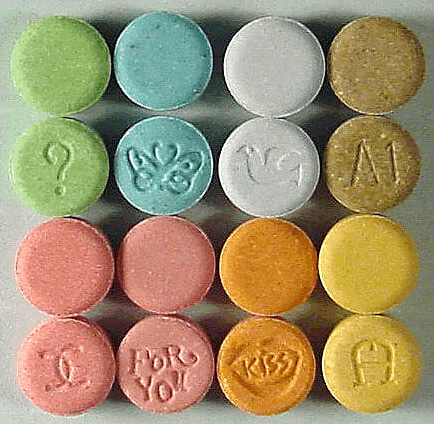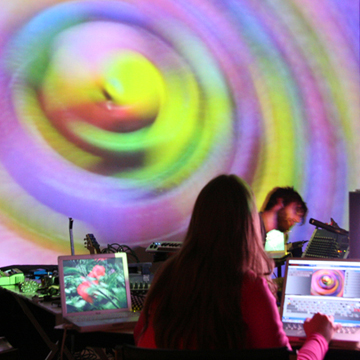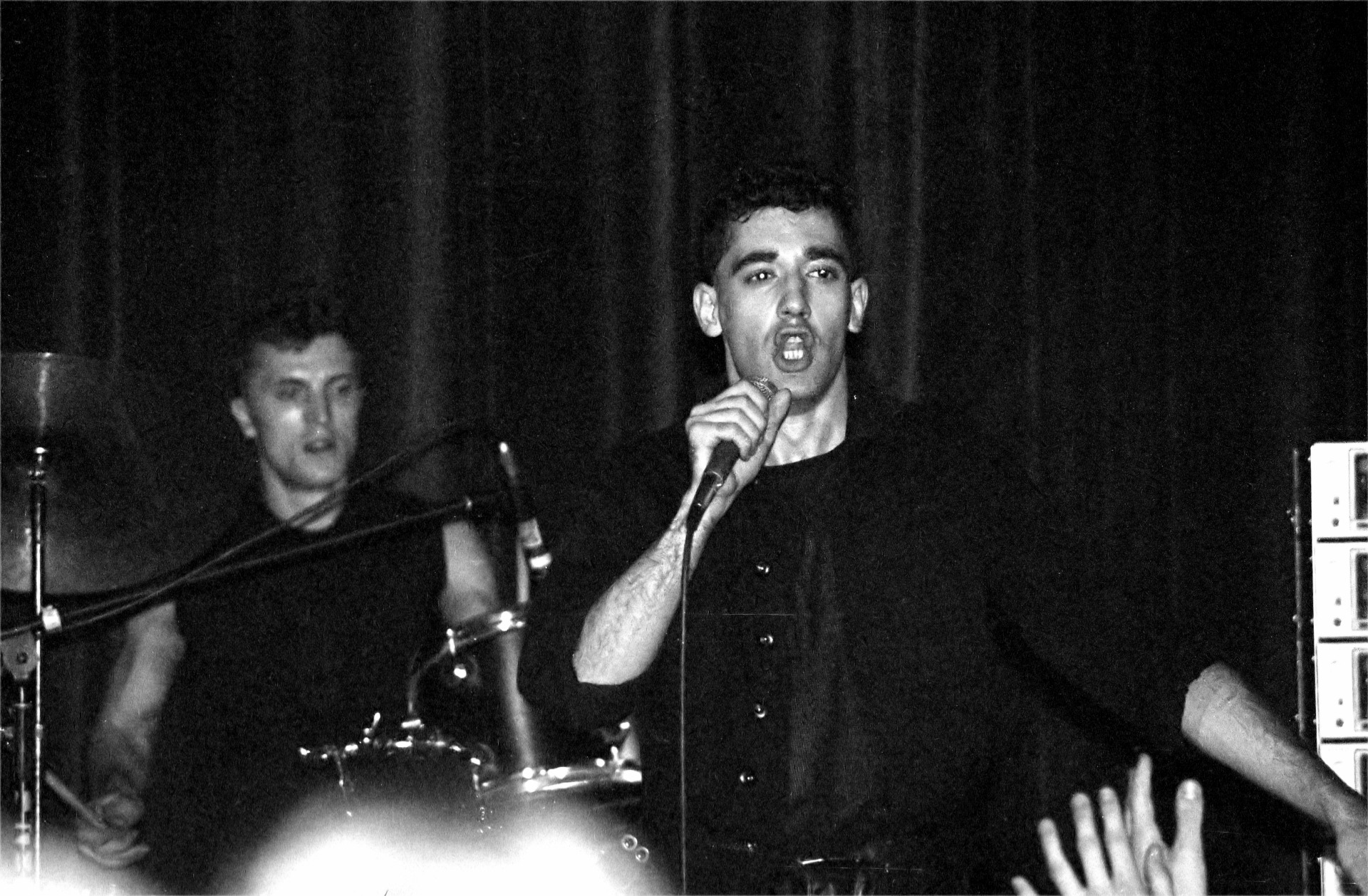|
Raves
A rave (from the verb: '' to rave'') is a dance party at a warehouse, club, or other public or private venue, typically featuring performances by DJs playing electronic dance music. The style is most associated with the early 1990s dance music scene when DJs played at illegal events in musical styles dominated by electronic dance music from a wide range of sub-genres, including techno, hardcore, house, and alternative dance. Occasionally live musicians have been known to perform at raves, in addition to other types of performance artists such as go-go dancers and fire dancers. The music is amplified with a large, powerful sound reinforcement system, typically with large subwoofers to produce a deep bass sound. The music is often accompanied by laser light shows, projected coloured images, visual effects and fog machines. While some raves may be small parties held at nightclubs or private homes, some raves have grown to immense size, such as the large festivals and even ... [...More Info...] [...Related Items...] OR: [Wikipedia] [Google] [Baidu] |
Algorave
An algorave (from an algorithm and rave) is an event where people dance to music generated from algorithms, often using live coding techniques. Alex McLean of Slub and Nick Collins coined the word "algorave" in 2011, and the first event under such a name was organised in London, UK. It has since become a movement, with algoraves taking place around the world. Description Algoraves can include a range of styles, including a complex form of minimal techno, and the movement has been described as a meeting point of hacker philosophy, geek culture, and clubbing. Although live coding is commonplace, any algorithmic music is welcome which is "wholly or predominantly characterised by the emission of a succession of repetitive conditionals", which is a corruption of the definition of rave music (“wholly or predominantly characterised by the emission of a succession of repetitive beats”) in the UK's Criminal Justice Act. Although algorave musicians have been compared with DJs, they ar ... [...More Info...] [...Related Items...] OR: [Wikipedia] [Google] [Baidu] |
Free Party
A free party is a party "free" from the restrictions of the legal club scene, similar to the free festival movement. It typically involves a sound system playing electronic dance music from late at night until the time when the organisers decide to go home. A free party can be composed of just one system or of many and if the party becomes a festival, it becomes a teknival. This typically means that drugs are readily available. The word ''free'' in this context is used both to describe the entry fee and the lack of restrictions and law enforcement. Motivations for organisers range from political protest to simply wanting to have fun. An example of free parties as political protest was their prominence during the M11 link road protest. At most parties no money is asked for entrance since the aim is not to make profit. However, at some (most often indoor) events it is requested at the door to make a donation to cover costs. Typically organisers make little profit or make a l ... [...More Info...] [...Related Items...] OR: [Wikipedia] [Google] [Baidu] |
Teknival
Teknivals (the word is a portmanteau of the words tekno and festival) are large free parties which take place for several days. They take place most often in Europe and are often illegal under various national or regional laws. They vary in size from dozens to thousands of people, depending on factors such as accessibility, reputation, weather, and law enforcement. The parties often take place in venues far away from residential areas such as squatted warehouses, empty military bases, beaches, forests or fields. The teknival phenomenon is a grassroots movement which has grown out of the rave, punk, reggae sound system and UK traveller scenes and spawned an entire subculture. Summer is the usual season for teknivals. History Teknivals are a larger scale version of free parties and emerged in the early 1990s, when acid house parties and travellers in Great Britain became the target of political repression, culminating in the Criminal Justice and Public Order Act 1994. Sectio ... [...More Info...] [...Related Items...] OR: [Wikipedia] [Google] [Baidu] |
Club Drug
Club drugs, also called rave drugs or party drugs, are a loosely defined category of recreational drugs which are associated with discothèques in the 1970s and nightclubs, dance clubs, electronic dance music (EDM) parties, and raves in the 1980s to today. Unlike many other categories, such as opiates and benzodiazepines, which are established according to pharmaceutical or chemical properties, club drugs are a "category of convenience", in which drugs are included due to the locations they are consumed and/or where the user goes while under the influence of the drugs. Club drugs are generally used by adolescents and young adults. This group of drugs is also called "designer drugs", as most are synthesized in a chemical lab (e.g., MDMA, ketamine, LSD) rather than being sourced from plants (as with marijuana, which comes from the cannabis plant) or opiates (which are naturally derived from the opium poppy). Club drugs range from entactogens such as MDMA ("ecstasy"), 2C-B ("nexus" ... [...More Info...] [...Related Items...] OR: [Wikipedia] [Google] [Baidu] |
Techno
Techno is a Music genre, genre of electronic dance music (EDM) which is generally music production, produced for use in a continuous DJ set, with tempo often varying between 120 and 150 beats per minute (bpm). The central Drum beat, rhythm is typically in common time (4/4) and often characterized by a repetitive four on the floor (music), four on the floor beat. Artists may use electronic instruments such as drum machines, sequencer (musical instrument), sequencers, and synthesizers, as well as digital audio workstations. Drum machines from the 1980s such as Roland Corporation, Roland's TR-808 and TR-909 are highly prized, and softsynth, software emulations of such retro instruments are popular. Much of the instrumentation in techno emphasizes the role of rhythm over other musical parameters. Techno tracks mainly progress over manipulation of timbre, timbral characteristics of synthesizer presets and, unlike forms of EDM that tend to be produced with synthesizer keyboards, techno ... [...More Info...] [...Related Items...] OR: [Wikipedia] [Google] [Baidu] |
Acid House
Acid house (also simply known as just "acid") is a subgenre of house music developed around the mid-1980s by DJs from Chicago. The style is defined primarily by the squelching sounds and basslines of the Roland TB-303 electronic bass synthesizer-sequencer, an innovation attributed to Chicago producers DJ Pierre of Phuture and Sleezy D. Acid house soon became popular in the United Kingdom and continental Europe, where it was played by DJs in the acid house and later rave scenes. By the late 1980s, acid house had moved into the British mainstream, where it had some influence on pop and dance styles. Acid house brought house music to a worldwide audience. The influence of acid house can be heard in later styles of dance music including trance, hardcore, jungle, big beat, techno and trip hop. Characteristics Acid house's minimalist sound combined house music's ubiquitous programmed four-on-the-floor 4/4 beat with the electronic squelch sound produced by the Roland TB-303 ... [...More Info...] [...Related Items...] OR: [Wikipedia] [Google] [Baidu] |
VJing
VJing (pronounced: ''VEE-JAY-ing'') is a broad designation for realtime visual performance. Characteristics of VJing are the creation or manipulation of imagery in realtime through technological mediation and for an audience, in synchronization to music. VJing often takes place at events such as concerts, nightclubs, music festivals and sometimes in combination with other performative arts. This results in a live multimedia performance that can include music, actors and dancers. The term VJing became popular in its association with MTV's Video Jockey but its origins date back to the New York club scene of the 70s. In both situations VJing is the manipulation or selection of visuals, the same way DJing is a selection and manipulation of audio. One of the key elements in the practice of VJing is the realtime mix of content from a "library of media", on storage media such as VHS tapes or DVDs, video and still image files on computer hard drives, live camera input, or from compu ... [...More Info...] [...Related Items...] OR: [Wikipedia] [Google] [Baidu] |
Nightclub
A nightclub (music club, discothèque, disco club, or simply club) is an entertainment venue during nighttime comprising a dance floor, lightshow, and a stage for live music or a disc jockey (DJ) who plays recorded music. Nightclubs generally restrict access to people in terms of age, attire, personal belongings, and inappropriate behaviors. Nightclubs typically have dress codes to prohibit people wearing informal, indecent, offensive, or gang-related attire from entering. Unlike other entertainment venues, nightclubs are more likely to use bouncers to screen prospective patrons for entry. The busiest nights for a nightclub are Friday and Saturday nights. Most nightclubs cater to a particular music genre or sound for branding effects. Some nightclubs may offer food and beverages (including alcoholic beverages). History Early history In the United States, New York increasingly became the national capital for tourism and entertainment. Grand hotels were built for upsc ... [...More Info...] [...Related Items...] OR: [Wikipedia] [Google] [Baidu] |
Trance Festival
Trance is a genre of electronic dance music that emerged from the British new-age music scene and the early 1990s German techno and hardcore scenes. Trance music is characterized by a tempo generally lying between 135–150 beats per minute (BPM), repeating melodic phrases and a musical form that distinctly builds tension and elements throughout a track often culminating in 1 to 2 "peaks" or "drops". Although trance is a genre of its own, it liberally incorporates influences from other musical styles such as techno, house, pop, chill-out, classical music, tech house, ambient and film music. A trance is a state of hypnotism and heightened consciousness. This is portrayed in trance music by the mixing of layers with distinctly foreshadowed build-up and release. A common characteristic of trance music is a mid-song climax followed by a soft breakdown disposing of beats and percussion entirely, leaving the melody or atmospherics to stand alone for an extended period before grad ... [...More Info...] [...Related Items...] OR: [Wikipedia] [Google] [Baidu] |
Industrial Dance
Electronic body music (acronymized to EBM) is a genre of electronic music that combines elements of industrial music and synth-punk with elements of disco and dance music. It developed in the early 1980s in Western Europe as an outgrowth of both punk and industrial music cultures. It combines sequenced repetitive basslines, programmed dance music rhythms, and mostly undistorted vocals and commandlike shouts with confrontational or provocative themes. The evolution of the genre reflected "a general shift towards more song-oriented structures in industrial as to a general turn towards the dancefloor by many musicians and genres in the era of post-punk."Timor Kaul: ''Electronic Body Music''. In: Thomas Hecken, Marcus S. Kleiner: ''Handbook Popculture.'' J.B. Metzler Verlag 2017, , p. 102–104. It was considered a part of the European new wave and post-punk movement and the first style that blended synthesized sounds with an ecstatic style of dancing (e.g. pogo). EBM gained ... [...More Info...] [...Related Items...] OR: [Wikipedia] [Google] [Baidu] |
2C-B
2C-B (4-Bromo-2,5-dimethoxyphenethylamine) is a psychedelic drug of the 2C family. It was first synthesized by Alexander Shulgin in 1974. In Shulgin's book '' PiHKAL'', the dosage range is listed as 12–24 mg. As a recreational drug, 2C-B is sold as a white powder sometimes pressed in tablets or gel caps. It is also referred to by a number of street names. The drug is usually taken orally, but can also be insufflated or vaporized. While being primarily a psychedelic it is also a mild entactogen. History 2C-B was synthesized from 2,5-dimethoxybenzaldehyde by Alexander Shulgin in 1974. It first saw use among the psychiatric community as an aid during therapy. 2C-B was first sold commercially as a purported aphrodisiac under the trade name "Erox", which was manufactured by the German pharmaceutical company Drittewelle. For several years, it was available as tablets in Dutch smart shops under the name "Nexus" and "B-Dub". Patterns of use 2C-B first became popularized in th ... [...More Info...] [...Related Items...] OR: [Wikipedia] [Google] [Baidu] |





.jpg)

